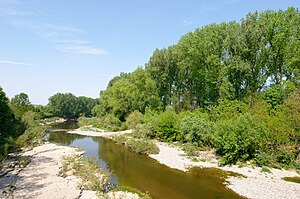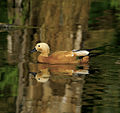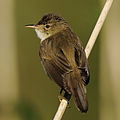Nature reserves Altneckar and Pleidelsheimer Wiesental
|
"Altneckar" nature reserve
|
||
|
View from the Freiberg Neckar Bridge into the Altneckar nature reserve |
||
| location | Pleidelsheim , Ingersheim , Freiberg am Neckar , Ludwigsburg district , Baden-Württemberg , Germany | |
| surface | 37.2 ha | |
| Identifier | 1,078 | |
| WDPA ID | 81276 | |
| Geographical location | 48 ° 57 ' N , 9 ° 11' E | |
|
|
||
|
"Pleidelsheimer Wiesental" nature reserve
|
|
| location | Pleidelsheim , Ludwigsburg district , Baden-Württemberg , Germany |
| surface | 6.8 ha |
| Identifier | 1,027 |
| WDPA ID | 82336 |
| Geographical location | 48 ° 57 ' N , 9 ° 11' E |
The nature reserves Altneckar and Pleidelsheimer Wiesental comprise one of the last near-natural sections of the Neckar in the Stuttgart administrative region as well as a former quarry pond on its banks. They extend to the districts of the communities Freiberg am Neckar , Pleidelsheim and Ingersheim .
Protection purpose
The nature reserve Altneckar serves to preserve this natural river stretch. During floods, the river bed and bank area are subject to flow-related changes several times a year; thus the Altneckar offers an example of natural flow dynamics. The typical flora and fauna of this habitat are equally protected.
The nature reserve Pleidelsheimer Wiesental is intended to maintain and develop a nationally significant community. This includes endangered animal and plant species, especially birds, amphibians and insects.
Origin and expansion
1911–1914, a canal for the Alt-Württemberg power plant in Pleidelsheim was dug east of the Neckar river . From 1954 this canal was expanded to become a shipping route. As a result, the old river bed was largely retained in its original form; in almost all other sections in the administrative district, the river itself was canalized.
During the construction boom of the post-war years, a number of quarry ponds were created in the Neckar valley for gravel extraction , which were mostly refilled later; the small lake in the Pleidelsheimer Wiesental was preserved.
In the 1970s, thanks to intensive wastewater treatment in its catchment area, the water quality of the Neckar, which was previously classified as polluted to very polluted in this section , improved . Many plant and animal species of the original flora and fauna on the river recovered. At the Pleidelsheim Small Lake , which was left to develop naturally, a new natural habitat was created. In 1965, at the request of the then head of the state bird sanctuary for Baden-Württemberg, this area was initially placed under nature protection for 12 years. In 1977 it was permanently designated as a nature reserve Pleidelsheimer Wiesental with an area of 6.8 hectares.
In 1979, the protected area was expanded: the entire old river course and its banks are now under nature protection as the Altneckar nature reserve.
The Altneckar nature reserve covers 37.2 hectares of total area on the Altneckar from the Freiberg-Beihingen weir to the Pleidelsheim lock . It includes the course of the river and its banks; where the river bends from west to north, there is also a small alluvial forest and a fallow area above the sliding slope .
On the eastern bank of the Neckar, the Pleidelsheimer Wiesental nature reserve joins the Altneckar nature reserve, which means that a contiguous area of 44 hectares is under protection. Today the nature reserves Altneckar and Pleidelsheimer Wiesental are FFH areas (flora, fauna, habitat) of the EU.
The course of the Altneckar river
With normal and weak water flow, most of the Neckar water is directed through the shipping canal. Therefore the Altneckar has little water most of the time; large parts of the river bed are visible. During periods of low precipitation in summer, the river bed can largely fall dry except for standing pools. Only during floods does the Altneckar turn into a raging river.
Between Freiberg, Pleidelsheim and Ingersheim the Neckar valley, which has the character of a steep Kerbtal above and below the area, widens to a gentle depression, the Pleidelsheimer Mulde . The river flows through the Upper Muschelkalk in a wide loop . The gray limestone layers of the upper shell limestone are clearly visible on the river bed, which is exposed most of the time. Above this base, the floodplain is filled with a several meter thick layer of sediment made of gravel, sand and silt . The Neckar gravel consists mainly of shell limestone and Keuper sandstone, which was carried down by the river from the upper reaches. This gravel was used as a component of concrete and extensively mined. After the designation of the Pleidelsheimer Wiesental as a nature reserve in 1965, no more gravel mining took place. On the Altneckar there are still isolated natural gravel banks.
Flood in the softwood floodplain on the Altneckar
Such pronounced floods in the hardwood floodplain are very rare on the Altneckar
flora
The regular flooding meant that different vegetation zones developed on the bank. The vegetation there can withstand temporary flooding or is even dependent on the supply of water. The sparsely overgrown gravel banks and reed beds lie above the low water line. Above it follows the softwood meadow with broken willow strips and white willow alluvial forest . The hardwood floodplain above is only weakly developed on the Altneckar.
About 210 plant species were found in both nature reserves, including rare species such as Blue Star , Perilla , Yellow Star, Yellow Anemone and Nettle silk . In the river bed there are aquatic plants and reeds, for example the flooding buttercup and the reed grass . Barbara's herb blooms on the gravel banks in summer . Neophytes such as the Indian balsam and the Jerusalem artichoke spread on the embankments .
- Plants at increasing distance from the bank
Low-growing real barbarian herb on the gravel bank
Infructescence of a bastard black poplar
fauna
A total of 180 bird species have been recorded in both protected areas. The gray heron colony contained eight occupied nests in 2010. Currently, in spring 2011, over 20 pairs of cormorants are breeding on the island in the lake . The 60 breeding bird species also include kingfisher , black kite , middle woodpecker , great crested grebe , little grebe , pond rail and coot . The red- backed shrimp and gray woodpecker that lived here a few years ago have disappeared as breeding birds; for this purpose, a pair of Mediterranean seagulls and a pair of Egyptian geese bred in the reserve in 2009 . The alluvial forest is the habitat of yellow mockers , orioles and nightingales . Teals overwinter every year in varying numbers on and on the quarry pond and on the Altneckar. Great egrets are occasional guests at the quarry pond, especially in the winter months. In 2009 a successful brood of the extremely rare night heron was detected, photographed and filmed on the island in the lake for the first time . A successful brood also took place there in 2010. The Wiesental is so far the only breeding site for the night heron in the Ludwigsburg district.
The area is habitat for three endangered classified as very bat species, namely Noctule , water and common pipistrelle . The grass snake , sea frog and yellow-bellied toad are among the reptiles and amphibians in the area .
79 species of wild bees have been identified, including the highly endangered wood leaf cutter bee .
23 fish species have been detected in Altneckar, including cash , gudgeon and loach , as well as rare species such as moderlieschen and sticklebacks .
Small organisms can be found in the cavities of the gravel banks of various types of mussels and water snails, as well as the larvae of mosquitoes , quiver flies and mayflies , river fleas and strudelworms . The occurrence of these small organisms is an important indicator of the water quality. They also serve as food for the fry and for waders .
Small creatures from the Altneckar: Asian mussels , in between a fly larva, lower left a crab, lower right a leech , right a dragonfly larva , probably Calopteryx virgo
Hazards
There were and are plans to build roads through the nature reserve. In Pleidelsheim, the mayor and local council sought for a bypass road north of the town for years. It should have crossed the entire Pleidelsheim and Ingersheimer Wiesental on a high bridge. A referendum on March 4, 2007, in which the majority of the citizens of Pleidelsheim voted against this bypass, finally put an end to these plans. In Freiberg am Neckar, the local council decided on November 28, 2006 with 18: 5 votes to strive for a bypass road through the landscape in the Neckar valley that would cross the Altneckar on a bridge. However, the city does not give this plan any great chances, as the area is specially protected by the EU as an FFH area.
As an easily accessible recreational area in the Stuttgart metropolitan area , the nature reserves are exposed to strong visitor pressure. This is particularly noticeable in the high accumulation of garbage after weekends or public holidays. Some visitors do not adhere to the prescribed routes and disregard the ban on making fires. Every now and then there is also overt vandalism. On April 24, 2011, a cormorant was found hanged; Ornithologists suspect the act of a fanatic.
In April 2015, the Ludwigsburg District Office issued an entry ban for the two nature reserves and a year-round leash requirement for dogs in the adjacent landscape protection area.
Even the Neckar itself washes debris through the valley when it floods. When the water has fallen, bushes and treetops hang full of plastic scraps in the floodplain.
Surroundings
The nature reserve is surrounded by landscape conservation areas on both sides of the Neckar . These include the Ingersheimer Wiesental on the left side of the Neckar and part of the slopes up to the plateau as well as part of the alluvial forest and meadow in the Freiberg am Neckar area. To the east of the nature reserves, the entire island between Altneckar and the canal is a landscape protection area, with the exception of the technical operating area at the Beihinger Weir.
The valley floor in the meadow meadows is traditionally used for hay meadows. These endure regular flooding and protect the soil from erosion. To the right of the Altneckar, however, a large part of this traditional meadow is now used as arable land. There are extensive orchards in the vicinity of the villages . Wine is grown on the steep slope in the Neckarbogen.
In the area between Ingersheim and Freiberg-Geisingen you can see former vineyards that have become overgrown or converted into hillside forests, fruit tree and garden plots.
Tobacco was grown on the sandy soil near Pleidelsheim until the 1960s. Today the sandy soil is used for growing asparagus.
In its southern part, the area is cut through by the A 81 , which crosses the Neckar here.
See also
Individual evidence
- ↑ a b c d e f Herr, Heike; Buchmann, Harald: Altneckar and Pleidelsheimer Wiesental . In: Wolf, Reinhart (Ed.): Nature reserves in the Stuttgart administrative region . Jan Thorbecke, Stuttgart 2007, ISBN 978-3-7995-5176-2 , pp. 556-558 .
- ↑ All historical information according to Otto Majer: Beihingen - Geisingen - Heutingsheim, history in numbers . Self-published by the city of Freiberg am Neckar, 1989
- ↑ Information board on site at the lake in the Pleidelsheimer Wiesental
- ↑ a b Ordinance of the Stuttgart Regional Council of October 1, 1979, published in the Law Gazette of December 14, 1979, p. 518, online at [1]
- ↑ a b König, Claus and Ingrid: Naturparadies im Neckartal (DVD) . new version. CIK nature film, Ludwigsburg 2009.
- ↑ a b c d e f g h i j k Fink, Conrad; Wolf, Reinhart: Altneckar and Pleidelsheimer Wiesental nature reserves . Ed .: Landesbank Baden-Württemberg Foundation: Nature and Environment. Stuttgart 2006.
- ↑ Citizens reject the northern bypass . Stuttgarter Nachrichten, March 7, 2007, online [2] , accessed April 24, 2011.
- ^ City of Freiberg am Neckar: Northwest bypass ( memento from May 9, 2015 in the Internet Archive ), accessed on April 24, 2011.
- ↑ Altneckar area closed. ( Memento from March 4, 2016 in the Internet Archive ) Ludwigsburger Kreiszeitung, April 27, 2015
literature
- Bischoff, Cornelia; Passing out, Helmut; Engelhardt, Martin: Maintenance and development plan for the NSG 'Altneckar' and the NSG 'Pleidelsheimer Wiesental' . Ed .: District Office for Nature Conservation and Landscape Management Stuttgart. Stuttgart 1999.
- König, Claus: Sea frog (Rana ridibunda) in the gravel pits near Pleidelsheim, Ludwigsburg district . In: Publ. Landesstelle Natursch. u. Landscaping Baden-Württemberg . tape 30 , 1962, pp. 260 .
- König, Claus: An endangered bird paradise at the gates of Stuttgart: the gravel pits of Pleidelsheim . In: Publ. Landesstelle Natursch. u. Landscaping Baden-Württemberg . No. 31 , 1963, pp. 153-164 .
- King, Claus; Schüz, E .: Pleidelsheim gravel pits - a valuable natural site before destruction? In: Swabian homeland . No. 3 , 1964, pp. 174-176 .
- King, Claus; Schwammberger, K .: Black-headed yellow wagtail at the gravel pits near Pleidelsheim, Ludwigsburg district . In: No. orn. Ges. Bavaria . tape 6 , no. 6 , 1963, pp. 570 .
- König, Claus: The bird world of the gravel pit area near Pleidelsheim am Neckar . In: Publ. Landesstelle Natursch. u. Landscaping Baden-Württemberg . No. 34 , 1966, pp. 87-101 .
Web links
- Altneckar nature reserve: Profile of the nature reserve in the LUBW's list of protected areas
- Nature reserve Pleidelsheimer Wiesental: Profile of the nature reserve in the protected area directory of the LUBW
- Leaflet with a map and explanations of the nature reserves (PDF download)




























